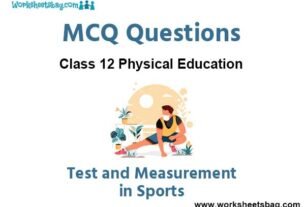Please refer to Production and Costs MCQ Questions Class 12 Economics below. These MCQ questions for Class 12 Economics with answers have been designed as per the latest NCERT, CBSE books, and syllabus issued for the current academic year. These objective questions for Production and Costs will help you to prepare for the exams and get more marks.
Production and Costs MCQ Questions Class 12 Economics
Please see solved MCQ Questions for Production and Costs in Class 12 Economics. All questions and answers have been prepared by expert faculty of standard 12 based on the latest examination guidelines.
MCQ Questions Class 12 Economics Production and Costs
Question. The basic reason of operating the Law of Diminishing Returns is:
(a) Scarcity of Factors
(b) Imperfect Substitution between Factors
(c) Both (a) and (b)
(d) None of the above
Answer
C
Question. Long-run production function is related to:
(a) Law of Demand
(b) Law of Increasing Returns
(c) Laws of Returns to Scale
(d) Elasticity of Demand
Answer
C
Question. Law of variable proportion explains three stages of production. In the first stage of production:
(a) Both MP and AP rise
(b) MP rises
(c) AP Falls
(d) MP is zero
Answer
A
Question. Production function is expressed as:
(a) Qx = Px
(b) Qx = f(A, B, C, D)
(c) Qx= Dx
(d) None of these
Answer
B
Question. The cycle which increases first and after being constant starts to reduce is called :
(a) APP
(b) MPP
(c) TPP
(d) All of these
Answer
D
Question. Law of variable proportion is related to :
(a) Both short-run and long run
(b) Long-run
(c) Short-run
(d) Very Long-run
Answer
C
Question. If all the factors of production are increased by same proportion and as a result output increases by a greater proportion than it is called :
(a) Constant returns to scale
(b) Decreasing returns to scale
(d) All of these
(d) None of these
Answer
D
Question. Which of the following is not fixed cost ?
(a) Insurance Premium
(b) Interest
(c) Cost of Raw Material
(d) Rent of the Factory
Answer
C
Question. Changes in production quantity affect:
(a) Both Fixed and Variable Cost
(b) Only Variable Cost
(c) Only Fixed Cost
(d) None of the above
Answer
B
Question. The alternative name of opportunity cost is:
(a) Economic Cost
(b) Equilibrium Price
(c) Marginal Cost
(d) Average Cost
Answer
A
Question. Which statement of the following is true ?
(a) AC=TFC – TVC
(b) AC = AFC + TVC
(c) AC=TFC + AVC
(d) AC = AFC + AVC
Answer
D
Question. The shape of average cost curve is :
(a) U-shaped
(b) Reactangular Hyperbola shaped
(c) Line parallel to x-axis
(d) None of these
Answer
A
Question. Which of the following is correct ?
(a) TVC = TC – TFC
(b) TC = TVC-TFC
(c) TFC = TVC + TC
(d) TC = TVC x TFC
Answer
A
Question. With increase in output, the difference between total cost and total variable cost:
(a) Decreases
(b) Increases
(c) Remains Constant
(d) None of the above
Answer
C
Question. Following figure shows:

(a) Total Fixed Cost
(b) Total Variable Cost
(c) Total Cost
(d) None of these
Answer
B
Question . If the short-run average variable costs of production for a firm are rising, then this indicates that:
(a) average total costs are at a maximum.
(b) marginal costs are above average variable costs.
(c) average fixed costs are constant.
(d) average variable costs are below average fixed costs.
Answer
B
Question. Which is not a quantitative method of credit control?
(a) Bank Rate
(b) Moral Suasion
(c) Open Market Operations
(d) Change in CRR
Answer
B
Question . ______ shows the overall output generated at a given level of input:
(a) Cost function
(b) Production function
(c) Iso cost
(d) Marginal rate of technical substitution
Answer
B
Question . The marginal product curve is above the average product curve when the average product is :
(a) Increasing
(b) Decreasing
(c) Constant
(d) None
Answer
A
Question. When was the minimum reserve system started in India?
(a) 1947
(b) 1948
(c) 1951
(d) 1957
Answer
D
Question. Indian Monetary System is based on ________
(a) Paper Standard
(b) Metallic Standard
(c) Gold Standard
(d) Credit Money Standard
Answer
A
Question. The ratio of total deposits that a commercial bank has to keep with RBI is called:
(a) Statutory liquidity ratio
(b) Deposit ratio
(c) Cash reserve ratio
(d) Legal reserve ratio
Answer
C
Question. Which one is the difficulty of the Barter System?
(a) Lack of Double Coincidence
(b) Difficulty of Division of the Goods
(c) Lack of General Acceptable Measure of Value
(d) All the above
Answer
D
Question. Which one is included in the primary function of money?
(a) Medium of Exchange
(b) Measure of Value
(c) Both (a) and (b)
(d) Store of Value
Answer
C
Question. The functions of money include:
(a) Value determination
(b) Store of value
(c) Means of exchange
(d) All of these
Answer
D
Question. During IInd stage of law of Diminishing returns:
(a) MP and TP is maximum
(b) MP and AP are decreasing
(c) AP is negative
(d) TP is negative
Answer
B
Question. Institution that accepts deposits for lending purpose is known as __________
(a) Commercial Bank
(b) Central Bank
(c) Government
(d) Public
Answer
A
Question. The law of diminishing returns only applies in cases where:
(a) there is increasing scarcity of factors of production.
(b) the price of extra units of a factor is increasing.
(c) capital is a variable input
(d) there is at least one fixed factor of production.
Answer
D
Question. Which function is the Secondary Function of Commercial Banks?
(a) Agency Function
(b) General Utility Function
(c) Social Function
(d) All of these
Answer
D
Question. The full form of ATM is:
(a) Any Time Money
(b) All Time Money
(c) Automated Teller Machine
(d) Both (a) and (b)
Answer
C
Question. RBI announced the guidelines to issue licenses to new banks of the private sector on:
(a) January 22, 1993
(b) March 15, 1995
(c) April 1, 1999
(d) None of these
Answer
A
Question. Law of diminishing returns to applicable in:
(a) Manufacturing industry
(b) Agriculture
(c) Neither (a) nor (b)
(d) Any economic activity at a point of time.
Answer
D
Question. How is Total Physical Product derived from Marginal Physical Product?
(a) Cumulative subtraction
(b) Cumulative addition
(c) Cumulative product
(d) Cumulative Division
Answer
B
Question. The major objectives of monetary policy is/are:
(a) Increase in output and employment
(b) Stability in the foreign exchange rate
(c) Price stability
(d) All of these
Answer
D
Question. Narasimham Committee is related to what:
(a) Improvement in Taxation
(b) Improvement in Banking
(c) Improvement in Agriculture
(d) Improvement in Infrastructure
Answer
B
Question. The meaning of money supply is:
(a) Money deposits in the bank
(b) Cash available with public
(c) Savings in the post office
(d) All of the above
Answer
D
Question. Implicit costs are:
(a) equal to total fixed costs.
(b) comprised entirely of variable costs.
(c) “payments” for self-employed resources.
(d) always greater in the short run than in the long run.
Answer
C
Question. What is Production in Economics:-
(a) Creation / Addition of Utility
(b) Production of food grains
(c) Creation of services
(d) Manufacturing of goods
Answer
A
Question. Which type of currency is issued by Central Bank?
(a) Currency
(b) Credit Money
(c) Coins
(d) All of these
Answer
A
Question. Which of the following issue paper currency in the country?
(a) Commercial Bank
(b) Central Bank
(c) World Bank
(d) Industrial Bank
Answer
B
Question. Suppose a firm sells its product at a price lower than the opportunity cost of the inputs used to produce it. Which is true?
(a) The firm will earn accounting and economic profits.
(b) The firm will face accounting and economic losses.
(c) The firm will face an accounting loss, but earn economic profits.
(d) The firm may earn accounting profits, but will face economic losses
Answer
D
Question. Commercial banks:
(a) Issue currency notes
(b) Accepts deposits from customers
(c) Provide loans to customers
(d) Only (b) and (c)
Answer
D
Question. Diminishing marginal returns implies:
(a) Decreasing average variable costs
(b) Decreasing marginal costs
(c) Increasing marginal costs
(d) Decreasing average fixed costs
Answer
C
Question. Banking Ombudsman Scheme was announced in the year:
(a) 1990
(b) 1995
(c) 1997
(d) 2000
Answer
B
Question. Which is associated with reforms in the banking sector?
(a) Year 1991
(b) Narsimham Committee
(c) Y.V. Reddy Committee
(d) Only (a) and (b)
Answer
D
Question. When a firm doubles its inputs and finds that its output has more than doubled, this is known as:
(a) economies of scale.
(b) constant returns to scale.
(c) diseconomies of scale.
(d) a violation of the law of diminishing returns.
Answer
A
Question. The shape of the Total Physical Product short run is
(a) Inverse U-Shaped
(b) U-Shaped
(c) Hyperbola
(d) V-Shaped
Answer
A
Question. Which of the following is the credit money?
(a) Cheque and draft
(b) Promissory note
(c) Exchange note
(d) All of these
Answer
D
Question. Variable costs are:
A) sunk costs.
(b) multiplied by fixed costs.
(c) costs that change with the level of production.
(d) defined as the change in total cost resulting from the production of an additional unit of output.
Answer
C
Question. The primary function of Commercial Bank is?
(a) Accepting Deposits
(b) Advancing Loans
(c) Credit Creation
(d) All of these
Answer
D
Question. Economies and diseconomies of scale explain why the:
(a) short-run average fixed cost curve declines so long as output increases.
(c) marginal cost curve must intersect the minimum point of the firm’s average total cost curve.
(b) long-run average total cost curve is typically U-shaped.
(d) short-run average variable cost curve is U-shaped.
Answer
C
Question. Giving permission to withdraw money by an amount more than deposited to is known as _________
(a) Advance
(b) Overdraft
(c) Loan
(d) None of these
Answer
B
Fill in the blanks:
Question. Returns to scale is related to ……………
Answer : Long term
Question. Increase in income from a unit of production is called ……………
Answer : Marginal cost
Question. Law of supply shows …………… relation between price and supply.
Answer : Direct
State true or false:
Question. Law of decreasing returns to scale arises due to Non-divisibility.
Answer : False
Question. In case of perfect competition, a firm attains maximum satisfaction when MC curve cut MR curve.
Answer : False
Question. The supply of perishable goods is inelastic.
Answer : True
Match the following:
| ‘A” | ‘B’ |
| 1. Causes for the operation of the law of diminishing returns | (a) Firms’s equilibrium |
| 2. Long term process | (b) Imperfect substitute of factors of production |
| 3. Marginal Revenue = Average Revenue. | (c) Returns to scale |
| 4. Elasticity of supply | (d) es = 1. |
| 5. Elastic supply | (e) Proportionate change in supply proportionate change in price. |
Answer :
| ‘A” | ‘B’ |
| 1. Causes for the operation of the law of diminishing returns | (b) Imperfect substitute of factors of production |
| 2. Long term process | (c) Returns to scale |
| 3. Marginal Revenue = Average Revenue. | (a) Firms’s equilibrium |
| 4. Elasticity of supply | (e) Proportionate change in supply proportionate change in price. |
| 5. Elastic supply | (d) es = 1. |



